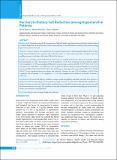Please use this identifier to cite or link to this item:
https://hdl.handle.net/20.500.14356/1539Full metadata record
| DC Field | Value | Language |
|---|---|---|
| dc.contributor.author | Ghimire, Saruna | - |
| dc.contributor.author | Shrestha, Naveen | - |
| dc.contributor.author | Callahan, Karen | - |
| dc.date.accessioned | 2023-05-16T05:07:36Z | - |
| dc.date.available | 2023-05-16T05:07:36Z | - |
| dc.date.issued | 2018 | - |
| dc.identifier.citation | GhimireS., ShresthaN., & CallahanK. (2018). Barriers to Dietary Salt Reduction among Hypertensive Patients. Journal of Nepal Health Research Council, 16(2), 124-130. https://doi.org/10.33314/jnhrc.v16i2.1026 | en_US |
| dc.identifier.issn | Print ISSN: 1727-5482; Online ISSN: 1999-6217 | - |
| dc.identifier.uri | http://103.69.126.140:8080/handle/20.500.14356/1539 | - |
| dc.description | Original Article | en_US |
| dc.description.abstract | Abstract Background: Despite knowing the ill consequences of high salt intake, many hypertensive patients in Nepal continue to consume high levels of salt in their diet. Hence, this study aims to reveal the barriers to dietary salt reduction among hypertensive patients in Nepal. Methods: A barrier analysis was conducted in the outpatient department of Sahid Gangalal National Heart Center, Nepal among 180 hypertensive patients under physician advice to reduce salt in their diet. A logistic regression modeling was used to calculate odds ratios (ORs) for the barriers. Results: Low self-efficacy (OR=0.04; 95%CI: 0.01-0.24) was a significant barrier to dietary salt reduction among study participants, as well as lack of taste (23.3% Compliant vs. 53.3% Non-Compliant) and lack of family support (5.6% compliant vs. 27.8% noncompliant).Difficulty in remembering to eat low salt (OR=3.89; 95%CI: 1.28-11.87) was a barrier for males. There were differences seen by gender in barriers: among female participants, low perceived social acceptability (OR=0.05; 95%CI: 0.01-0.32), and living in a joint rather than nuclear family (OR=0.21; 95%CI: 0.06-0.77) were significant barriers to dietary salt reduction. Presence of a son (7.8% Compliant vs.30.0% Non-Compliant) and/or husband (1.1% Compliant vs. 11.1% Non-Compliant) had an influence on females’ decisions to reduce salt. Conclusions: Perceived self-efficacy, reminder to action, social acceptability, and family structure were barriers to dietary salt reduction among hypertensive patients in Nepal. Presence of a son and/or husband had an influence on females’ decisions to reduce salt. Addressing the modifiable barriers identified in this study is important for successful salt reduction initiatives in Nepal. The inclusion of a son and/or husband in nutritional counseling may be beneficial to achieve salt reduction in this population. Keywords: Barriers; hypertension; Nepal; salt reduction. | en_US |
| dc.language.iso | en | en_US |
| dc.publisher | Nepal Health Research Council | en_US |
| dc.relation.ispartofseries | Apr-June, 2018;1026 | - |
| dc.subject | Barriers | en_US |
| dc.subject | Hypertension | en_US |
| dc.subject | Nepal | en_US |
| dc.subject | Salt reduction | en_US |
| dc.title | Barriers to Dietary Salt Reduction among Hypertensive Patients | en_US |
| dc.type | Journal Article | en_US |
| local.journal.category | Original Article | - |
| Appears in Collections: | Vol. 16 No. 2 Issue 39 Apr-Jun 2018 | |
Files in This Item:
| File | Description | Size | Format | |
|---|---|---|---|---|
| 1026-Manuscript-5260-1-10-20180703.pdf | Fulltext Download | 298.35 kB | Adobe PDF |  View/Open |
Items in DSpace are protected by copyright, with all rights reserved, unless otherwise indicated.
